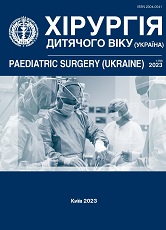First experience of implantation of diaphragm pacemakers in infant with bilateral diaphragmatic paralysis
DOI:
https://doi.org/10.15574/PS.2023.78.127Keywords:
newborn, bilateral diaphragmatic paralysis, treatmentAbstract
Phrenic nerve injury is not frequent, but well recognized complication of birth trauma caused by brachial plexus injury. Diaphragmatic paresis is usually unilateral, and cases of bilateral damage are rare. Diaphragmatic paralysis led to development of severe respiratory disorders, which required the prolonged intensive care, often with the applying of mechanical ventilation. Although is it possible the spontaneous restoration the function of the diaphragm, this requires the long-term of respiratory support. The general accepted guidelines of the treatment of infants with paresis/paralysis of diaphragm is absent. Diaphragmatic plication considered as the main surgical method of treatment. By that, diaphragmatic plication not always had a positive effect.
The aim of the study was to present new possibility in the treatment of infants with bilateral diaphragmatic paralysis.
Clinical case. We presented the first experience of transthoracic implantation of diaphragm pacemaker in infant with bilateral diaphragmatic paralysis.
The newborn was hospitalized with the respiratory disorders’ syndrome. The paresis of both hemidiaphragms was reviled on chest X-ray. For 7 months child required the mechanical ventilation, due to unsuccessful attempts to transfer the child to spontaneous breathing caused the decrease of saturation. With the aim to restore spontaneous breathing, the implantation of diaphragm pacemaker, under the thoracoscopic control, was performed initially at the right side and next at the left side. The effectiveness of the treatment was confirmed by the electroneuromyography and ultrasonography.
Conclusions. Implantation of the diaphragmatic pacemaker my be the method of treatment in infants with bilateral diaphragmatic paralysis.
The research was carried out in accordance with the principles of the Helsinki Declaration. The informed consent of the patient was obtained for conducting the studies.
No conflict of interests was declared by the authors.
References
Aldrich TK, Herman JH, Rochester DF. (1980). Bilateral diaphragmatic paralysis in the newborn infant. J Pediatr. 97 (6): 988-991. https://doi.org/10.1016/S0022-3476(80)80442-2; PMid:7441433
Bhaskar P, Lone RA, Sallehuddin A et al. (2016). Bilateral diaphragmatic palsy after congenital heart surgery: management options. Cardiol Young. 26 (5): 927-930. https://doi.org/10.1017/S1047951115001559; PMid:26345716
Bowerson M, Nelson VS, Yang LJ. (2010). Diaphragmatic paralysis associated with neonatal brachial plexus palsy. Pediatr Neurol. 42 (3): 234-236. https://doi.org/10.1016/j.pediatrneurol.2009.11.005; PMid:20159438
Commare MC, Kurstjens SP, Barois A. (1994). Diaphragmatic paralysis in children: a review of 11 cases. Pediatr Pulmonol. 18 (3): 187-193. https://doi.org/10.1002/ppul.1950180311; PMid:7800436
Dagan O, Nimri R, Katz Y et al. (2006). Bilateral diaphragm paralysis following cardiac surgery in children: 10-years' experience. Intensive Care Med. 32 (8): 1222-1226. https://doi.org/10.1007/s00134-006-0207-5; PMid:16741697
Gibson GJ. (1989). Diaphragmatic paresis: pathophysiology, clinical features, and investigation. Thorax. 44 (11): 960-970. https://doi.org/10.1136/thx.44.11.960; PMid:2688182 PMCid:PMC462156
Hoeksma AF, ter Steeg AM, Nelissen RGHH et al. (2004). Neurological recovery in obstetric brachial plexus injuries: an historical cohort study. Dev Med Child Neurol. 46 (2): 76-83. https://doi.org/10.1111/j.1469-8749.2004.tb00455.x
Joho-Arreola AL, Bauersfeld U, Stauffer UG et al. (2005). Incidence and treatment of diaphragmatic paralysis after cardiac surgery in children. Eur J Cardiothorac Surg. 27 (1): 53-57. https://doi.org/10.1016/j.ejcts.2004.10.002; PMid:15621471
Kraaijenga JV, Hutten GJ, de Jongh FH, van Kaam AH. (2015). Diagnosis of hemidiaphragmatic paresis in a preterm infant with transcutaneous electromyography: A case report. Neonatology. 108 (1): 38-41. https://doi.org/10.1159/000381207; PMid:25968010
Muller NL, Bryan AC. (1979). Chest wall mechanics and respiratory muscles in infants. Pediatr Clin North Am. 26 (3): 503-516. https://doi.org/10.1016/S0031-3955(16)33745-2; PMid:386235
Murty VSSY, Ram KD. (2012). Phrenic nerve palsy: a rare cause of respiratory distress in newborn. J Pediatr Neurosci. 7 (3): 225-227. https://doi.org/10.4103/1817-1745.106487; PMid:23560016 PMCid:PMC3611918
Qureshi A. (2009). Diaphragm paralysis. Semin Respir Crit Care Med. 30 (3): 315-320. https://doi.org/10.1055/s-0029-1222445; PMid:19452391
Radecki LL, Tomatis LA. (1976). Continuous bilateral electrophrenic pacing in an infant with total diaphragmatic paralysis. J Pediatr. 88 (6): 969-971. https://doi.org/10.1016/S0022-3476(76)81051-7; PMid:1083902
Rizeq YK, Many BT, Vacek JC et al. (2020). Diaphragmatic paralysis after phrenic nerve injury in newborns. Pediatr Surg. 55 (2): 240-244. https://doi.org/10.1016/j.jpedsurg.2019.10.038; PMid:31757507
Shimizu M. (2003). Bilateral phrenic-nerve paralysis treated by thoracoscopic diaphragmatic plication in a neonate. Pediatr Surg Int. 19 (1-2): 79-81. https://doi.org/10.1007/s00383-002-0737-z; PMid:12721731
Shiohama T, Fujii K, Hayashi M et al. (2013). Phrenic nerve palsy associated with birth trauma - case reports and a literature review. Brain Dev. 35 (4): 363-366. https://doi.org/10.1016/j.braindev.2012.06.002; PMid:22742777
Stramrood CA, Blok CA, van der Zee DC, Gerards LJ. (2009). Neonatal phrenic nerve injury due to traumatic delivery. J Perinat Med. 37 (3): 293-296. https://doi.org/10.1515/JPM.2009.040; PMid:19199838
Van Smith C, Jacobs JP, Burke RP. (1998). Minimally invasive diaphragm plication in an infant. Ann Thorac Surg. 65 (3): 842-844. https://doi.org/10.1016/S0003-4975(98)00008-3; PMid:9527232
Downloads
Published
Issue
Section
License
Copyright (c) 2023 Paediatric Surgery (Ukraine)

This work is licensed under a Creative Commons Attribution-NonCommercial 4.0 International License.
The policy of the Journal “PAEDIATRIC SURGERY. UKRAINE” is compatible with the vast majority of funders' of open access and self-archiving policies. The journal provides immediate open access route being convinced that everyone – not only scientists - can benefit from research results, and publishes articles exclusively under open access distribution, with a Creative Commons Attribution-Noncommercial 4.0 international license(СС BY-NC).
Authors transfer the copyright to the Journal “PAEDIATRIC SURGERY.UKRAINE” when the manuscript is accepted for publication. Authors declare that this manuscript has not been published nor is under simultaneous consideration for publication elsewhere. After publication, the articles become freely available on-line to the public.
Readers have the right to use, distribute, and reproduce articles in any medium, provided the articles and the journal are properly cited.
The use of published materials for commercial purposes is strongly prohibited.

